Contents
The taste and aroma of moonshine, as well as its safety for health, largely depends on third-party impurities that enter the distillate from raw materials, as a result of the vital activity of yeast or during its distillation. Modern equipment and compliance with the rules of fractional distillation solves almost 100% of the problems associated with these impurities, but often the conditions are far from ideal and the moonshine has to be cleaned from smell, unpleasant tastes and harmful compounds. In this article, we tried to systematize and analyze all the methods of cleaning moonshine at home and draw certain conclusions for each of them.
Almost all components of moonshine, except for water, are harmful to our body and are, in fact, poison. Not all of them are equally dangerous (ethanol, for obvious reasons, we immediately exclude), and some of them endow the drink with the very “bouquet” of tastes and aromas for which we are engaged in distillation (and then we will only talk about it). But these components are dangerous and their quantity must be minimized, which is what this material is dedicated to. So, from what we will clean:
- methanol (methyl alcohol) – the simplest monohydric alcohol that has the smell of ethanol. Its boiling point is only 64,7оC, that is, logically, it should go headlong with fractional distillation, but in practice everything is much more complicated. Fortunately, the content of matanol in sugar and grain moonshine is insignificant (for example, for sugar – no more than 0,01 mg / l), so it can be immediately ignored. It is not recommended to clean fruit distillates according to the methods described below, since organoleptics (a combination of tastes and aromas) suffer greatly.
- Acetaldehyde (acetic aldehyde) – an organic compound, aldehyde of ethanol and acetic acid. Formed during the oxidation of ethanol. Moonshine can contain quite large quantities (up to 400 mg / l and more), which can be very dangerous to health. In small concentrations, it is easily “digested” by the body to harmless acetic acid and gives the distillate a certain, familiar taste.
- Fusel oil – a mixture of higher monohydric aliphatic alcohols, ethers and other compounds. When it comes to cleaning moonshine from the smell, in most cases they mean the nauseating smell of fusel oil. The most dangerous component of sivukha is isoamyl alcohol. However, it should be understood that the taste profile of moonshine, especially grain, depends very much on the presence of certain components of fusel oil in it.

Canadian Crystal Head vodka is filtered three times through quartz crystals known as Herkimer diamonds.
I would like to immediately note that when discussing cleaning methods, we are primarily talking about sugar moonshine and partially grain (wheat, for example, can be cleaned) – it is not recommended to clean fruit and most grain distillates, as this can greatly worsen their organoleptic. Moreover, we are talking exclusively about the distillation of drinks, and not their rectification (haters-rectifiers do not need to read the article).
Well, before you start: the most effective and expedient way to obtain a pure distillate with pleasant organoleptics is the second fractional distillation with an accurate cut-off of “heads” and “tails”. If you use good equipment and follow all the rules of fractional distillation, then you do not need to clean the moonshine. Strive for it first! But if the equipment or knowledge does not yet allow you to get a good product after the second distillation, then purification will be appropriate. So, how can you clean moonshine from fusel oil and other impurities? Read on!
Purification of moonshine before distillation
A good start is half the battle. Properly prepared mash in compliance with the technology will provide a cleaner moonshine with a pleasant organoleptic. This has long been confirmed not only by practice, but also by scientific methods. So, laboratory analyzes show that when using a smaller amount of dry yeast in the mash, raw alcohol (hereinafter SS) is obtained with a significantly lower content of fusel oil, isoamylol, isobutanol and others like it.
There is also evidence that when the mash is fermented at a higher temperature (30оC) in SS there is a smaller amount of fusel oil, but also less esters, from which we can conclude that a higher temperature is preferable for sugar mash, but vice versa for fruit mash. As for the clarification of mash, a lot is written about this in the recipe for sugar moonshine, and the process itself, I think, is mandatory.
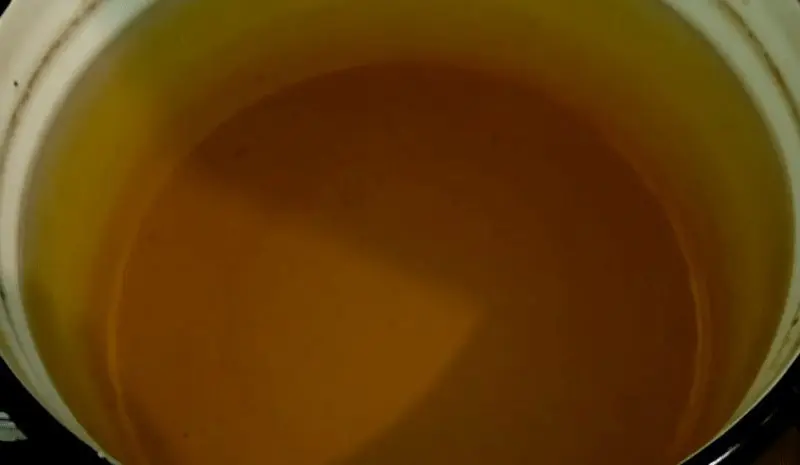
Local output: for the preparation of sugar mash, we use half the amount of yeast and observe a higher temperature regime. This is not a paradigm, but a certain turn in distillation, which should be taken into account and, at a minimum, be tested empirically on a small amount of distillate. Clarification of mash is a prerequisite for obtaining high-quality moonshine.
Methods for cleaning moonshine before the second distillation
After receiving the clarified mash, it should be distilled as quickly as possible, without separating the head and tail fractions, if it is a grain or fruit distillate, or with crushing, if it is moonshine from sugar (not a paradigm – a recommendation). Before the obligatory second distillation, it is recommended that the obtained SS be cleaned of fusel oil and other impurities, which should have a positive effect on the finished product. For this, chemical cleaning, coagulant cleaning, physical oil cleaning and carbonization are used. Let’s talk about each method in more detail and draw the appropriate conclusions.
Chemical purification of raw alcohol
Chemical purification refers to the treatment of the SS with various chemical reagents in order to neutralize some of the impurities present in the distillate after the first distillation. This technology came to us directly from distilleries. The technique is based on the saponification of an alcohol solution with alkali (soda ash or caustic soda), which reacts with acids, neutralizing them, and the subsequent neutralization of the alkaline medium with potassium permanganate (potassium permanganate). The result: an insoluble flake residue containing a certain proportion of the “stinky” and “harmful” impurities from the SS.
On practice! The technique was developed on the basis of the information presented in the book “Production of alcoholic beverages”, Dorosh A.K., Lysenko V.S. For 1 liter of absolute alcohol in SS, you need to take 4 g of soda ash, 0,4 g of potassium permanganate and 2 g of caustic soda (from the forum: for 10 liters of 40% distillate, you need to take 2 tsp of soda ash, 1 / 3-1 / 2 tsp potassium permanganate, 1-1,5 tsp caustic soda). Cleaning method: soda ash (sodium carbonate, Na2CO3) is dissolved in 200 ml of boiled water and poured with stirring into the SS, potassium permanganate (potassium permanganate, KMnO4), also dissolved in water, and after 15-20 minutes – caustic soda (sodium hydroxide, caustic soda, NaOH) dissolved in a glass of water. After 15-20 hours of settling, the SS is drained from the formed precipitate and is necessarily subjected to a second fractional distillation).
Chemical cleaning from Western colleagues: for 1 liter of 50% SS, add 1 g of caustic soda dissolved in a glass of water. Wait 2 to 12 hours with occasional stirring. Do a pH test to make sure the medium is very alkaline (8-14pH). If everything is in order, add as much potassium permanganate by weight as sodium hydroxide was added (we will first dissolve potassium permanganate in water). After that, wait 15-20 hours until precipitation occurs. Then remove the SS from the sediment and distill. As an oxidizing agent, potassium permanganate can be replaced with 30% hydrogen peroxide (do not ask for proportions, I did not find an adequate manual).
Local output: chemical cleaning, of course, is an effective means of improving moonshine, and the Dorosh-Lysenko method described above has been tested by hundreds of experienced moonshiners. But recently, especially with the development of the distiller’s technical equipment, more and more practitioners refuse it – it is difficult to calculate the required amount of chemicals for a particular SS without preliminary laboratory analysis. There is only one conclusion that can be drawn here: if you are looking for a ready-made recipe for the chemical purification of moonshine, then this cannot exist in nature, and blindly following the instructions is more likely to worsen the quality of the distillate than improve it and, in the end, can harm the health of drinkers.
Coagulant purification of raw alcohol
Speaking in human terms, there is a certain group of substances, coagulants, which, when they enter the solution, “stick together” various compounds, forming larger fractions that can be filtered. In this case, various compounds mean fusel oil, esters, as well as a suspension that could somehow get into the distillate.
The principle of cleaning moonshine with coagulants is based on the content of proteins (casein and albumin) in some products, which coagulate in an alcohol solution of a certain strength, along the way “capturing” “stinky” impurities into the sediment, as they have adsorbing properties. Egg white and milk are usually used as such products.
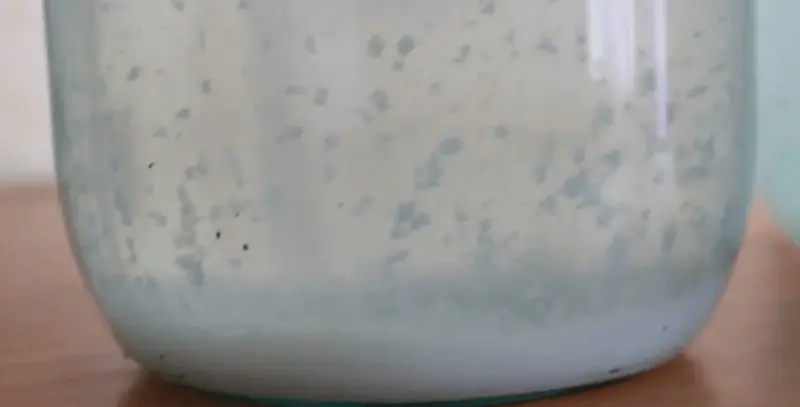
Cleaning moonshine with egg white: for 1 liter of SS, take 1-2 fresh chicken eggs, carefully separate the proteins, beat, add a glass of water, beat again and add to the SS. Wait until the protein coagulates and precipitates, filter, send for distillation. The difficulty of this method lies in the fact that the protein is reluctant to fold in a weak solution of alcohol – for fast folding, the distillate strength should be more than 40%, better than 50%. After the first distillation on a simple apparatus, it usually has a much lower strength. In addition, after the second distillation of protein-purified SS, a hydrogen sulfide smell or a boiled egg smell can be traced in the final product.
Cleaning moonshine with milk: for 10 liters of SS add 1 liter of skimmed (or up to 1,5% fat) milk, wait for the formation of a precipitate (can be accelerated with citric acid or lemon juice), filter, dilute and for the second distillation. The problems are the same as with egg white: the distillate often smells of hydrogen sulfide and can remain cloudy (here you need to practice long and hard in slow distillation in order to prevent burning, etc.).
Local output: cleaning moonshine with egg white and milk before the second distillation is a rather controversial technique that is more likely to worsen the organoleptics than to improve it. Similar purification methods are also used after the second distillation, when you need to soften the distillate, and this is perhaps a more sensible approach, but with its own troubles.
Cleaning raw alcohol with oil
The method is based on the ability of some components of fusel oil to dissolve in other oils, while alcohol diluted to a certain strength does not dissolve in oil. At home, it is recommended to use refined vegetable oil without odors.
The method of cleaning with oil is as follows: SS at room temperature is diluted to 15-30% (this is necessary not only to prevent the dissolution of alcohol in the oil, but also for more effective cleaning), poured into a container with filling it by no more than 2/3 of the total volume , add 20 ml of oil per 1 liter of solution and mix vigorously. You need to mix three times for a minute with breaks of one to two minutes. After 12 hours, the main amount of oil should collect on the surface of the vessel (it is better to defend in a cool place) and the SS can be drained, leaving the bulk of the oil film in the container. After that, the SS must be thoroughly filtered through a cotton filter and / or a carbon column, and then distilled a second time with the separation of heads and tails.
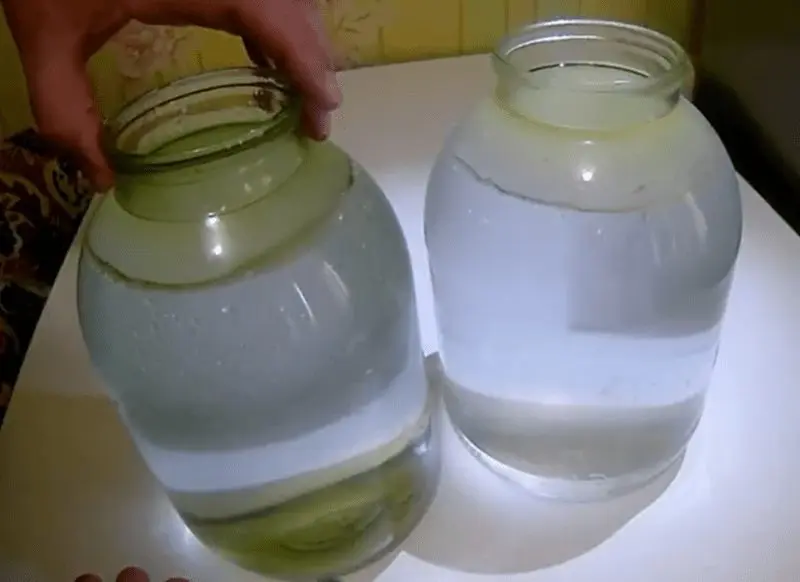
Local output: cleaning moonshine with oil is an effective and, perhaps, the most harmless way to improve the quality of SS before the second distillation. The technique itself is mentioned in the work of Dorosh-Lysenko, has some scientific justification, shows a good, stable result and is always recommended as the main method of intermediate cleaning of moonshine.
Purification of raw alcohol with activated carbon
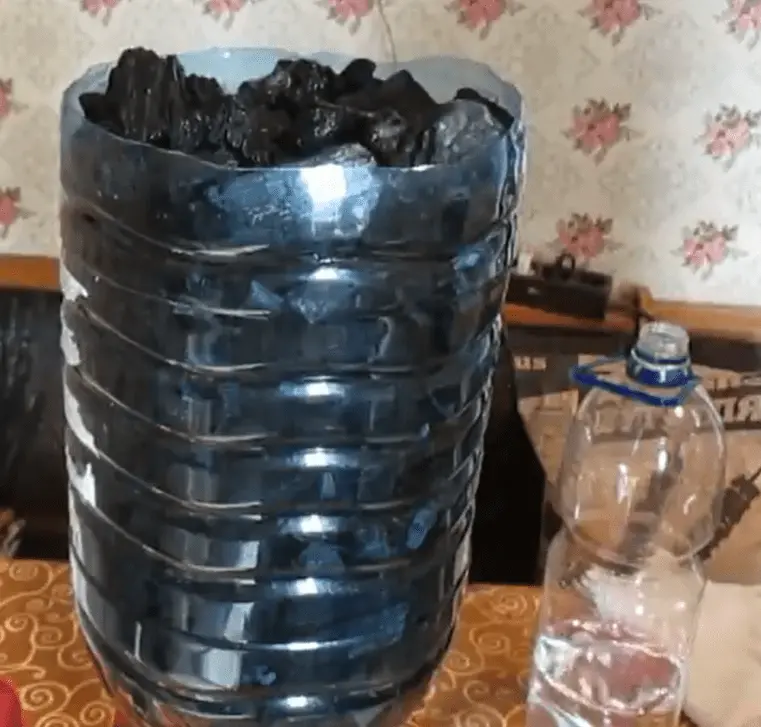
Primitive coal filter column of flow type for purification of moonshine
Much has been said about the purification of moonshine with activated carbon in a separate article on our website, which describes in detail the “infusion” method of carbonization. To clean the SS, it is better to use carbonization in the “column” way. There are laboratory studies confirming that after cleaning the SS in this way, the concentration of fusel oil in it is significantly reduced. This technique does not need a local conclusion, since it is considered generally recognized and effective at all stages of the preparation of high-quality distillate, including after the second distillation to give the drink a vodka taste. In the near future, material will be prepared on “column” carbonization and the manufacture of an efficient coal column.
Purification of moonshine by the second fractional distillation
It doesn’t need to be introduced, there is a separate material that describes in more than detail the process of fractional distillation, including with “catching easy” – a method for cleaning moonshine from isoamyl alcohol. There is only one local conclusion here: repeated fractional distillation of distillate is the most effective way to clean moonshine at home. But the degree of purification is highly dependent on the equipment available and skills in distillation. In the process of mastering this skill, without having more modern moonshine stills, before the second fractional distillation of sugar moonshine and some grain distillates, an intermediate purification is desirable.
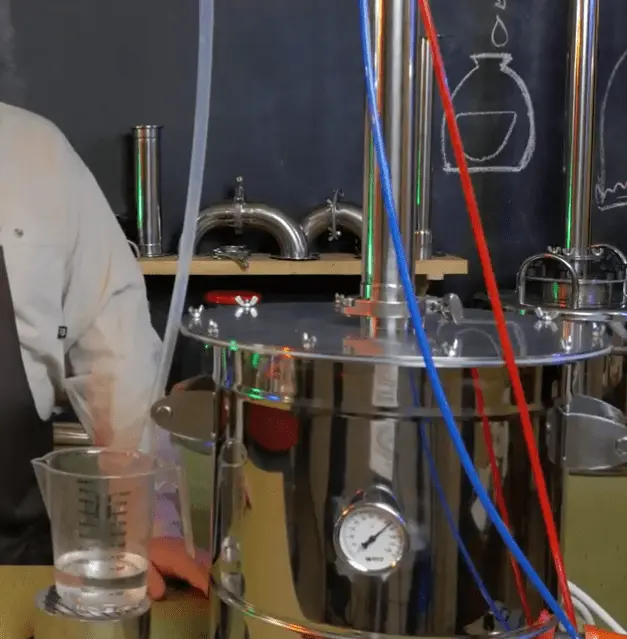
Purification of moonshine after the second distillation
In theory, after fractional distillation, the distillate does not need to be cleaned, but in practice, especially for beginners, moonshine still may not have the most pleasant smell and taste. In such cases, I personally recommend doing another distillation with a more careful separation of moonshine into fractions, but if greed jumped in you, then you can try some ways to further clean the finished product (and still lose in quantity).
Coagulant purification of distillate
The same cleaning methods are used: egg white and milk. Cleaning with egg white is carried out according to the same scheme and gives an acceptable result. Before cleaning, moonshine must be diluted to a drinking fortress, given that during the cleaning process the degree will drop by 2-3%. There are significant disadvantages: moonshine often acquires not the most pleasant egg flavor, and it is very, very difficult to filter the sediment. When cleaning the finished product with milk, which is preferable, you should reduce its amount per liter of moonshine or use powdered milk.
On practice: for 1 liter of moonshine drinking strength (42-45%, you need to take a little stronger, since cleaning with milk steals a couple of degrees) take 10 ml of fresh skimmed or low-fat milk or 0,62 g of powdered milk. Powdered milk should be diluted in 10 ml (for every 0,62 g) of warm boiled water and let the flakes swell for 2-3 hours, fresh – diluted with water 1: 1. Pour the solution into the distillate, mix well and leave to stand in a cool place until a precipitate forms and the distillate is completely clarified (from 1 hour to several days, depending on the quality of the milk). If the curdling of milk has not started after 6-7 hours, you can add a little citric acid or lemon juice (lemon on the tip of a knife, repeating until the milk curdles). After complete clarification, drain from the sediment and, if necessary, filter (it is possible through a carbon column).
Local output: as a way of softening and slight cleaning of the finished product takes place, but the result is highly dependent on the quality of the milk. It is not uncommon for moonshine to remain cloudy and no filtering will help here. Also, a distinct milky flavor can be traced in the final product.
Purification of distillate with activated carbon
I will not repeat myself, the principle has not changed. After carbonation, the finished product acquires a vodka taste due to the oxidation of alcohol: ethanol -> acetaldehyde -> acetic acid -> etc. If you don’t like this taste, then carbonization is not appropriate and it is not necessary to carry out it at this stage, especially if the technology is violated, the distillate concentrates acetaldehyde, and this is an unpleasant smell and a terrible hangover in the morning. In subsequent materials, we will study in more detail the methods of cleaning moonshine with coal, but for now, be content with the previously mentioned article with “infusion” charcoal.
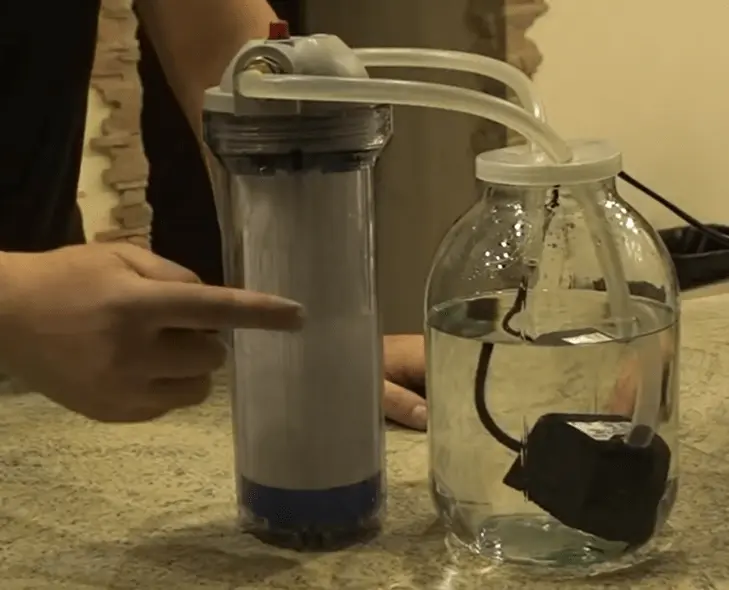
Charcoal filter from a Chinese pump and a container for coal, as an effective system for continuous carbonation of moonshine.
Moonshine smell masking
An ineffective technique that many mistakenly confuse with cleaning moonshine. The bottom line is to mask the unpleasant odor in the drink with various products, such as the pulp of rye bread, rice, buckwheat, pearl barley, etc. I personally don’t see the point in this. If you are sure that your distillate is safe for health, but the smell did not work out, then make any tincture based on it, the recipes of which on our resource are just a huge amount. Why soak the bread crumb, if you can cook an amazing “Borodino”? If the smell of moonshine is simply unbearable, then the technology of its production is clearly violated – such a product is not subject to consumption, only intermediate cleaning and re-distillation.
In the order of delirium – distillate freezing
Many “respectable” resources recommend freezing it out as a way to clean moonshine, saying that water, with the transition to a crystalline form, takes with it fuselage and other abominations, which is why the distillate becomes, well, just virgin purity.
Wake up! Alcohol is a solvent and the greater its concentration, the better it dissolves various impurities. During freezing, the concentration of alcohol increases, along with the ability to dissolve. Freezing will help in only one thing – increasing the strength of the distillate, while increasing the concentration of all impurities present in it. By the way, for the curious, in the USA they practice the so-called sublimation distillation, when raw materials, for example, apple cider, are frozen all winter, thus obtaining a stronger drink (specifically, applejack is obtained from apple raw materials). There is no mention of any cleaning here.

Everyone goes crazy in their own way. Icelandic Reyka vodka is filtered through lava rocks from Icelandic volcanoes.
Global cleanup output
There are many ways to clean moonshine from smell and harmful impurities, but not all of them are equally effective or have a lot of nuances, while others are completely crazy or dangerous to health. Some of them I decided, out of harm’s way, not to mention at all.
After analyzing all the data, I have long ago deduced for myself the following algorithm for obtaining high-quality moonshine (mainly sugar and in the absence of the ability to conduct a decent level of distillation): proper preparation of mash and its thorough clarification, intermediate cleaning with oil with charcoal, fractional distillation without subsequent manipulations with the finished product (I don’t like the taste of vodka). I have no complaints about intermediate chemical cleaning, but without proper knowledge and skills, I do not recommend putting it into practice. The softening of distillate with milk as a technique deserves the right to life, but before its application, a series of experiments will have to be carried out in order to find a suitable raw material for this. I cannot recommend other methods of cleaning the SS and the finished product, since I see them as untenable.
PS I do not pretend to authority. What is described in the material is only my thoughts and conclusions. To trust them or not to trust is a purely personal matter. Comments are welcome, but without swearing and any vulgarity (such as “but my grandfather …”, “and my dad, doctor of science …”, etc., etc.).









